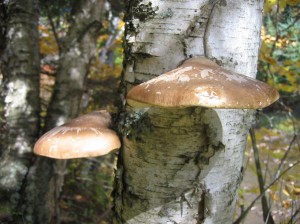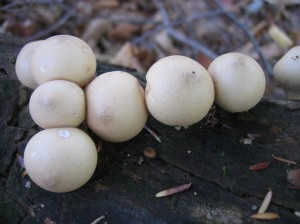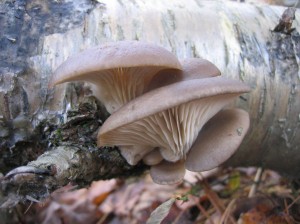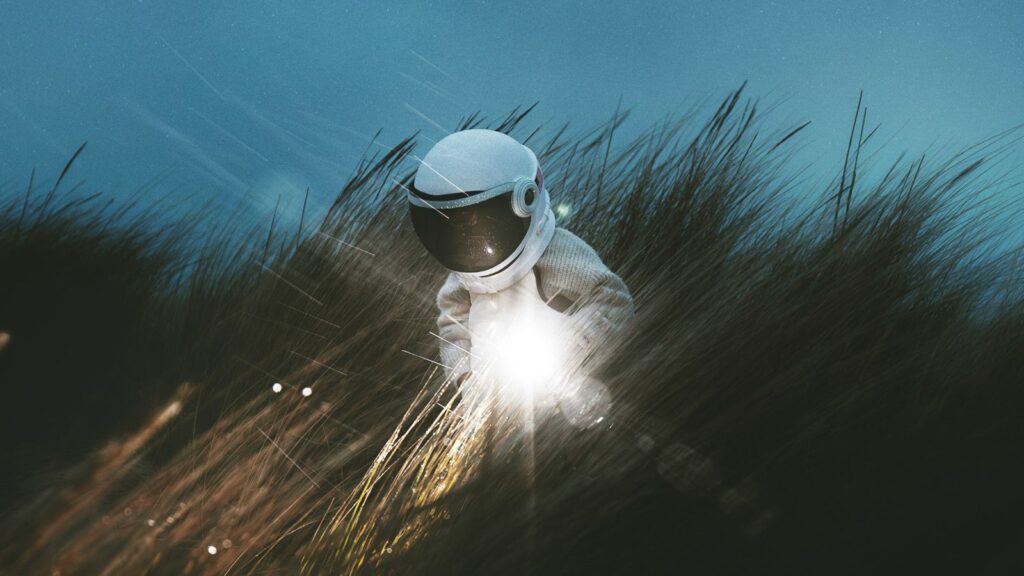The following is due to be published in the Journal of the Northeast Herbal Association, a wonderful organization deserving of your support.
The use of mushrooms as medicine is ancient. In Europe we have the example of Ötzi, the Man in the Ice, who carried along with him on his last journey through the Alps five thousand years ago dried pieces of Piptoporus betulinus, or birch polypore, long established as an effective remedy for gastrointestinal parasites.[i] In eastern Asia there are centuries of written documentation of the inclusion of fungi in the materia medica, including many of the mushrooms most popular today.

If we consider the strength of traditional use as well as modern scientific research, we find a half dozen or so medicinal mushrooms as forming the strongest core of our fungal materia medica: Ganoderma spp. (Reishi), Cordyceps sinensis, Trametes versicolor (turkeytail), Lentinus edodes (shiitake), Grifola frondosa (maitake), and Inonotus obliquua (chaga). Here is the Northeastern United States we have the good fortune of having four of these species readily available in our woods; I regularly gather reishi, maitake, chaga, and turkeytail. In addition, shiitake is easily cultivated; without much effort an herbalist can grow her or his own shiitakes in sufficient quantity to supply food and medicine for family and practice. That leaves Cordyceps as the only “core” medicinal mushroom not readily available to gather, and not as easily cultivated as mycelium at home.
Another distinct if ironic advantage we have in the Northeast is that even these major remedies are underused by herbalists. We who are out hunting for and gathering wild mushrooms have less competition than in many parts of the country and indeed the world where culinary and medicinal uses of mushrooms are more established. (This will doubtless begin to change as more people begin to gather wild foods and medicines, and mushrooms in particular continue to grow in much deserved popularity.) For example, whereas John and Tina Chen write in their seminal book Chinese Medical Herbology and Pharmacology that “wild-crafted Ling Zhi [reishi] is rare and difficult to collect”[ii], in our region this supreme remedy – and out of all the medicinal plants and fungi the one I use the most – is in fact abundant and easy to find (both G. lucidum and G. tsugae). I have found maitake, Reishi and turkeytail equally in rural, suburban, and urban settings (this fall I gathered a beautiful maitake in the heart of Brooklyn).
Turkeytail, which is in fact the most scientifically studied medicinal mushroom of all and highly prized in particular in Japan, is greatly underutilized by herbalists in the U.S. despite being abundant. At the same time, these major remedies have been written about extensively elsewhere and new articles and publications are emerging on a regular basis. It is now fairly easy to find reliable high quality information on the therapeutic uses of these mushrooms, and for that reason I want to focus here on some mushrooms found in our region that are less appreciated and more seldom used. While true that there is less in the way of documented traditional usage and certainly less modern research conducted on the mushrooms discussed below, there is enough known for us to begin incorporating these fungi into our materia medica along with their more popular cousins.
I will also not discuss lion’s mane or Hericium erinaceus since it also has been written about so extensively elsewhere. Suffice it to say that it can be found readily in our region as well as other Hericium species, and they are all quite flavorful as well as important medicine.
There are many mushrooms that could be discussed. I have chosen three that are generally abundant (puffballs, oyster mushrooms, and birch polypore), and one that is of special interest (huitlacoche).
Puffball (Langermannia and Lycoperdon spp.)

In the Northeast we have three species of puffball that are fairly common from midsummer to mid-Autumn:
- The giant puffball (Langermannia gigantea) which can grow to a size of two feet or more in diameter, and is generally found as a solitary fruiting body on lawns or on the forest floor in open woods.
- Two species of small puffball, Lycoperdon perlatum (gem-studded puffball or Devil’s snuffbox) which is found as a solitary fruiting body or in small clusters growing from the ground, and Lycoperdon pyriforme, generally found in large clusters on decaying wood. (The scientific name of pyriforme literally translates as “pear-shaped wolf fart”.)
All true puffballs are edible (but be careful to learn what a false or pigskin puffball looks like, or a young Amanita in button stage). I refer to them as “wild tofu” because they not are milder in flavor than most wild mushrooms and have white or off-white fleshy interiors somewhat the consistency of tofu.
Although they may not be chemically identical all puffballs studies so far seem to share certain properties. Puffballs can be a significant dietary source of trace minerals, especially zinc and selenium (although lower in Se than some other mushrooms most notably of the genus Boletus).[iii] [iv]
Medicinally, Lycoperdon spp. have been found to have significant antimicrobial and antioxidant activity.[v] In particular they stand out as important herbal first aid remedies. The dry powdery spores of L. pyriforme, which can be collected from the fruiting body, have been used for their hemostatic activity in the treatment of wounds.[vi]
Jonathan Pereira wrote in 1853 that “the spongy capillitium with the sporidia has been employed for staunching blood: thus it has been used as a plug in epistaxis, hemorrhage from the teeth, rectum, &c. The spongy base is employed as tinder. The fumes of this fungus, when burnt, are said to possess a narcotic quality, and have been employed to stupefy bees.”
This last action, a stupefying or narcotic effect, deserves more attention. On May 28, 1853 Benjamin W. Richardson addressed the Medical Society of London on the subject, and his paper On the Anesthetic Properties of the Lycoperdon Proteus, or Common Puffball, was subsequently published by the Society. Richardson, intrigued by the use of puffball burning to sedate the bees while the beekeeper opened and worked the hive, conducted various experiments on animals to determine its usefulness as an anesthetic. He found that inhalation of the smoke from a burning puffball consistently sedated the animal within several minutes to the point where they would lose all motor control, void their bowels and sometimes vomit, sometimes losing consciousness, other times remaining conscious but unable to respond. The narcotic effect was powerful enough to allow him to perform surgery without any response from the affected animal. The animals would also successfully recover; in one experiment he used puffball smoke to drug a kitten, bringing its hear rate down to eight beats per minute and lowering its body temperature, and saw it recover fully by the following day. In other cases the animal would recover much more quickly.
Richardson also cruelly if not unsurprisingly deliberately killed animals as well in order to learn about the puffball’s effects. He writes: “I have intentionally destroyed a great many animals with the narcotic, in order to observe how it would produce death. The respirations fail in a gradual and progressive manner, until they cease altogether, and the breathing sounds are dry and loud. The pupil is usualy dilated and fixed for several minutes previous to absolute death.
Taking this into consideration, any usage of puffball smoke should obviously be done with great caution. Richardson also notes that the smoke is very irritating to the throat and eyes. Intrigued by this, I found with a quick on-line search several documented cases in recent times of acute respiratory illness in both dogs and people from inhaling an excessive quantity of puffball spores.
It should be noted that there are no reports (at least that I could find) of any narcotic effect in any way from eating puffballs; they are widely considered perfectly safe to eat and I personally have eaten large amounts many times without noticing any sedative properties. It would however be interesting to investigate if there is a mild sedative or nervine effect from regular ingestion similar to that of Reishi or fu ling (Wolfiporia cocos).
The Eclectic physicians did not use medicinal fungi to any great extent when compared with modern-day herbalists in the U.S., but they did include fungi in their materia medica. Felter and Lloyd write of the giant puffball that it was “used at one time as a local haemostatic. Said to be anodyne and antiseptic, and to be a good application to cancerous growths, to allay pain and check bleeding. Porcher, from personal experience, declared Giant puff ball to possess some narcotic power. A tincture has been used in nervous affections and the dry powder in intertrigo” [an inflammatory rash in the folds of skin caused by microbial infection]. Felter and Lloyd also discuss Richardson’s experiments with this fungus, and comment that the narcotic “effects have been attributed to carbonic oxide, the gas given off when the puff ball is burned.”[vii]
Although puffballs do not play a prominent role in Chinese herbal medicine Christopher Hobbs lists another species of puffball, Calvatia bovista (ma bo) as having been mentioned at least as far back as the Pen T’sao, a Chinese materia medica published in the 16th Century.
Birch polypore (Piptoporus betulinus)
The birch polypore is a perfect example of the adage “know your tree, know your mushroom”. It is found exclusively on birches and is quite common and abundant, growing circumboreally in Asia, eastern North America, and Europe. Its traditional use in Europe as an anthelmintic or antiparasitic remedy was mentioned above in reference to Ötzi. When young the tender outer tips of the fruiting body can be eaten, but generally this is a mushroom that would be used as medicine not food.
Smith, Sullivan, and Rowe list the medicinal actions of Piptoporus as antitumor, antifungal, antiviral, anti-parasitic, and as having broad spectrum antibiotic activity,[viii] and Stamets describes it is an effective antimicrobial remedy both topically and internally, and as effective against melanoma.[ix] There is at least one study showing anti-cancer activity of an ethanol extract, which “highly decreased the viability of cancer cells, slightly inhibiting proliferation and tumor cell adhesion in a time- and dose-dependent manner.”[x]
Christopher Hobbs writes that the triterpenes and potentially other constituents found in P. betulinus have demonstrated antitumor/antineoplastic activity, and animal experiments have also shown some potential antiviral activity through the stimulation of interferon production. In addition, it can be used as a styptic (or hemostatic) when roasted down into charcoal.[xi]
Huitlacoche / Corn smut (Ustilago maydis)

Ustilago maydis is a parasitic fungus on corn (maize) that generally infects the ovaries of the corn transforming the kernels into enlarged, grayish bloated-looking fruiting bodies. It is considered a pest to be eradicated by U.S. farmers, where it is known by the name corn smut. In contrast Ustilago has a long history in Mexico as a delicacy, although in no way an elite or gourmet food – it is widely prepared and sold by street vendors for example, and I have personally had some of the most delicious dishes of it at roadside stands on rural Mexican dirt roads. Its Aztec name, huitlacoche or cuitlacoche, still used today, is variously and confusingly translated as “degenerate corn”, “sleeping corn”, “black excrement”, or “raven’s excrement”.[xii]
Huitlacoche, now sometimes called Mexican truffle in a modern-day rebranding effort, is so delicious that I have celebrated upon finding it in my garden. It is high in glutamic acid imparting the savory or umami flavor, and its flavor has been described on occasion as having a hint of vanilla. It is also arguably more nutritious than the corn it grows on. Nutritionally it contains almost all the essential and non-essential amino acids (and is in fact one of the foods found to highest in lysine in particular), antioxidant constituents, B vitamins and folates, and niacin. Somewhat surprisingly Ustilago contains significant levels of essential fatty acids, such as oleic and linoleic acid, which may be due to the higher fat content found in corn than other substrates fungi tend to grow on. For most likely the same reason, huitlacoche is also high in sugar content, more even than the corn it parasitizes. Huitlacoche is also higher in dietary fiber than most edible mushrooms such as oyster mushrooms and boletes.[xiii]
On the other hand, some of the chemistry in Ustilago closely resembles other fungi, such as the medically active beta-glucans that have proven immunomodulating and anti-cancer activity.[xiv]
Ustilago has some clear traditional medicinal indications within Native North American as well as indigenous Mexican tradition. This includes use in midwifery to induce contractions when needed, an action that has been attributed to the presence of ustilagine “which is similar in its properties to ergotamine obtained from ergots (Claviceps purpurea).”[xv] Used for this purpose, Maximino Martinez describes it as superior to ergot (known in Mexico as cuernecillo de centeno), because it does not result in irregular contractions.[xvi] This is consistent with the prominent Eclectic physician Finely Ellingwood’s clinical observations from a century ago. He writes that Ustilago, which he calls Corn Ergot, is “not so irritating in its influence, for, while possessing power, it works in a smooth, even and pleasant, but positive manner. It produces uterine contractions of a perfectly regular, intermittent and safe character, thus possessing a great advantage over the rye ergot.” He goes on to write that it presents no danger to the newborn infant when used for this purpose, and that it is also highly effective in cases of post-partum hemorrhage and uterine hemorrhage, and metrorrhagia.[xvii]
Felter and Lloyd also cite the clinical use of Ustilago for passive bleeding from the lungs and bowels, to relieve “false pains” in the final months of pregnancy, and impaired cerebral circulation with dizziness, blurred vision, headache on the top of the head, and unsteadiness. They also cite its usefulness as a general uterine tonic in cases of dysmenorrhea and other menstrual irregularities, and ovarian irritation. (It should also be noted that Felter and Lloyd also cite some adverse effects from Ustilago, but this is generally not shared in other sources, and may be a result of using very concentrated doses. In food-like doses it is quite safe.)[xviii]
Historically it has been used to promote healthy digestion, and is now being investigated in Mexico for efficacy in treating hyperlipidemia and for improving cognitive function,[xix] and “is also valued as a homeopathic remedy, being used, in accordance with the medical descriptions, primarily for diseases of the female reproductive organs.”[xx]
Hobbs also cites usages for alopecia, dry scalp, and urticaria, and as a mild laxative and curative for gastric ulcers .[xxi]
Oyster mushroom (Pleurotus ostreatus complex)

Oyster mushrooms can be found easily in many parts of the Northeast, often in large clusters totaling several pounds each. Oyster mushrooms as a whole (the oyster “complex”) are not difficult to identify, but as Bessette and Fischer point out, exact “species are highly variable and difficult to separate, even using microscopic features”.[xxii] Pleurotus grows on dying or dead trees, logs, or stumps; they are parasitic decomposers but considered facultative not obligate parasites, meaning they can persist on a dead tree (log, stump etc.) and do not require a living host.[xxiii] They are one of our more flexible edible mushrooms, in the sense that they can be found throughout the late summer and fall and even into the early winter if the weather is sufficiently mild, and grow on a wide variety of tree species, both hardwood and conifer.
Oysters, known as hiratake in Japan, are also easily cultivated; Bessette and Fischer recommend simply drilling holes in logs of suitable species such as poplar or willow and stuffing pieces of mushroom into them.[xxiv] I have personally never tried that simple method, but I have grown oyster mushrooms on logs using sawdust spawn and found it to be straightforward and rewarding. As of 2002 the oyster mushroom was the third most widely cultivated mushroom in the world (after Agaricus and shiitake) and has been grown in the U.S. since 1900. [xxv]
Nutritionally oysters can provide a significant source of dietary protein, up to 30% total content, including all amino acids except tryptophan and rivaling animal protein. They also contain significant levels of provitamin D (ergosterol), Vitamins B1, B2, B5 (niacin), B6, B7, thiamine, riboflavin, a wide-spectrum of mineral content, and essential fatty acids.[xxvi] Pleurotus also has exhibited strong potential to lower blood glucose levels and triglycerides, making it an important food for metabolic syndrome and Diabetes Types I and II.[xxvii]
The medicinal uses of oyster mushrooms are fairly established and derive from cultural traditions from around the world, including Asia, Europe, South America and
Africa.[xxviii] Christopher Hobbs writes that Pleurotus has held a place in the Chinese materia medica at least since the Pen T’sao Kang Mu written in 1578. Known as tian hua xin, it is considered to be sweet and mild in its activity, and is used to strengthen veins and relax the tendons, joints, and muscles; to dispel air and cold, and to inhibit worms and benefit the respiratory tract.[xxix]
Modern research has unsurprisingly validated these uses as well as added to our knowledge of its therapeutic value. Studies indicate that the beta-glucans (notably pleuran) found in oyster mushrooms have tumor-inhibiting activity and can potentially prevent metastasis. There are also indications that Pleurotus may confer some degree of protection from carcinogenic chemical exposure.[xxx] Smith, Rowan, and Sullivan list the activities of Pleurotus ostreatus as antiviral, antibacterial and anti-parasitic, nerve tonic, anti-inflammatory, antitumor, and anti-hyperlipidemic.[xxxi] Oyster mushrooms produce natural statins – more so in the caps than in the stems, and especially in the spores and mature gills. Other mushrooms, in particular woodland mushrooms, produce statins but Pleurotus is so far known to have the highest concentration. Orally consumed oyster mushrooms as part of the diet can have significant blood lipid normalizing effects; in one study VLDL was reduced by 65-80% and total lipids by 40%.[xxxii]
Oyster mushroom also exhibits clear benefits for respiratory health. A placebo-controlled clinical trial in 2013 showed a marked reduction in the rate of flu and other respiratory infection in children suffering from recurrent respiratory tract infections (RRTIs) while taking a combination of Vitamin C and an oyster mushroom-derived extract of pleuran, over the control group taking Vitamin C alone.[xxxiii] Similarly, Paul Stamets writes: “the submerged fermentation of the mycelium of…Pleurotus ostreatus…has shown effectiveness against Aspergillus niger, one of the most aggressive of all molds and one of the fungi causing aspergillosis lung disease, a malady that can pose a serious threat to persons with compromised immune systems.”[xxxiv]
Interestingly, Pleurotus has also demonstrated anti-viral activity and contains a “ubiquitin-like protein” which prevents reverse transcriptase activity of retro-viruses such as HIV-1.[xxxv]
References
- Bessette, Bessette, Fischer, Mushrooms of Northeastern North America, Syracuse University Press, 1997
- Chen, John, Chen, Tina, Chinese Medical Herbology and Pharmacology. Art of Medicine Press, 2004
- Cyranka M, Graz M, Kaczor J, Kandefer-Szerszeń M, Walczak K, Kapka-Skrzypczak L, Rzeski W., Investigation of antiproliferative effect of ether and ethanol extracts of birch polypore medicinal mushroom, Piptoporus betulinus (Bull.:Fr.) P. Karst. (higher Basidiomycetes) in vitro grown mycelium, Int J Med Mushrooms. 2011;13(6):525-33.
- Falandysz, Selenium in edible mushrooms, J Environ Sci Health C Environ Carcinog Ecotoxicol Rev. 2008 Jul-Sep;26(3):256-99.
- Ellingwood, Finley, American Materia Medica, Therapeutics and Pharmacognosy, 1919
- Felter, Lloyd, King’s American Dispensatory, 1898
- Fischer, D., Bessette, A., Edible Wild Mushrooms of North America, University of Texas Press, 1992
- Halpern, G., Healing Mushrooms, Square One Publishers, 2007
- Hobbs, C., Medicinal Mushrooms, 3rd Edition, Interweave Press, 1996
- http://bioweb.uwlax.edu/bio203/2011/wojcik_kyle/medicinal%20properties.htm
- Index Fungorum http://www.indexfungorum.org
- Jesenak M, Majtan J, Rennerova Z, Kyselovic J, Banovcin P, Hrubisko M., Immunomodulatory effect of pleuran (β-glucan from Pleurotus ostreatus) in children with recurrent respiratory tract infections, Int Immunopharmacol. 2013 Feb;15(2):395-9.
- Jorhem L, Sundström B., Levels of some trace elements in edible fungi, Z Lebensm Unters Forsch. 1995 Oct;201(4):311-6.
- Juárez-Montiel, Margarita, Sandra Ruiloba de León, Griselda Chávez-Camarillo, César Hernández-Rodríguez, Lourdes Villa-Tanaca, Huitlacoche (corn smut), caused by the phytopathogenic fungus Ustilago maydis, as a functional food, Rev Iberoam Micol. 2011;28(2):69–73
- Martinez, M, Las Plantas Medicinales de Mexico Ediciones Botas Mexico, cuarta edicion, 1959
- Pereira, Jonathan, The Elements of Materia Medica and Therapeutics, Vol. II, 3th American ed., 1853.
- Ramesh, Manohar, Pattar, Antimicrobial properties, antioxidant activity and bioactive compounds from six wild edible mushrooms of western ghats of Karnataka, India, Pharmacognosy Res. 2010 Mar-Apr; 2(2): 107–112.
- Richardson, Benjamin W., On the Anesthetic Properties of the Lycoperdon Proteus, or Common Puffball, read before the Medical Society of London, on May 28, 1853.
- Smith, Rowan and Sullivan, Medicinal Mushrooms: Their therapeutic properties and current medical usage with special emphasis on cancer treatments, University of Strathclyde, May 2002
- Stamets, P., MycoMedicinals, 3rd Edition, Mycomedia Productions, 2002
- Stamets, Paul, Novel Antimicrobials from Mushrooms, Herbalgram 2002;54:28-33
- Tierra, Michael, Treating Cancer with Herbs, Lotus Press, 2003
- Yance, D., Adaptogens in Medical Herbalism, Healing Arts Press, 2013
Notes
[i] Stamets, Herbalgram p.29
[ii] Chen and Chen, p. 771
[iii] Falandysz, p.256-299
[iv] Jorhem, p. 316
[v] Ramesh, Pattar p.112
[vi] http://bioweb.uwlax.edu/bio203/2011/wojcik_kyle/medicinal%20properties.htm
[vii] Felter, Lloyd, p.364
[viii] Smith et al., p. 26, 188
[ix] Stamets, p.17
[x] Cyranka et al.
[xi] Hobbs, p.185
[xii] Juárez-Montiel et al., p.70
[xiii] Juárez-Montiel et al, p 73
[xiv] Juárez-Montiel et al, p.71
[xv] http://www.kew.org/science-conservation/plants-fungi/ustilago-maydis-maize-smut
[xvi] Martinez p. 408
[xvii] Ellingwood, pp.152-153
[xviii] Felter, Lloyd, pp.2034-2036
[xix] http://www.informador.com.mx/tecnologia/2012/424657/6/hallan-propiedades-nutraceuticas-en-el-huitlacoche.htm
[xx] http://www.kew.org/science-conservation/plants-fungi/ustilago-maydis-maize-smut
[xxi] Hobbs p.187
[xxii] Bessette, Bessette, Fischer, p.232
[xxiii] Sullivan et al. p.17
[xxiv] Bessette, Fischer, p.89
[xxv] Sullivan et al. p. 65-67
[xxvi] Hobbs: p.56, p147
[xxvii] Sullivan et al. pp.185-6
[xxviii] Sullivan et al. p.49
[xxix] Hobbs, p.29
[xxx] Stamets, pp.55-56
[xxxi] Smith, Rowan, Sullivan, p.26
[xxxii] Hobbs, p.37
[xxxiii] Jesenak et al.
[xxxiv] Stamets Herbalgram p.30
[xxxv] Stamets: p. 16














